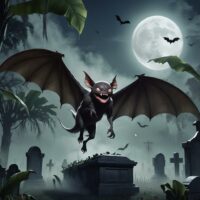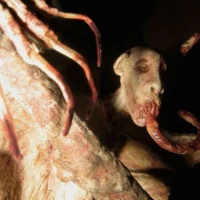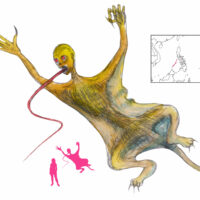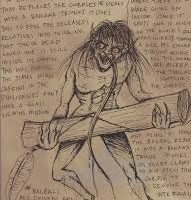Bal-Bal : The Corpse Thief
Listen
At a glance
| Description | |
|---|---|
| Origin | Philippine Mythology |
| Classification | Hybrids |
| Family Members | N/A |
| Region | Philippines |
| Associated With | Graveyards, Corpse stealing |
Bal-Bal
Introduction
The Bal-Bal is one of the most unsettling and enigmatic figures in Philippine mythology. Unlike other monsters that terrorize the living, this creature haunts the dead, feasting on human corpses and desecrating sacred burial rites. As part of the wider pantheon of mythical beings known across the Philippines, the Bal-Bal has become a potent symbol of fear, often mentioned in whispered stories passed down through generations. Associated with themes of death, decay, and the afterlife, it plays a unique role in the country’s cultural and spiritual landscape. Rooted particularly in the lore of the Tagbanua people of Palawan, its legend continues to evolve, merging old superstitions with new interpretations.
Physical Traits
The Bal-Bal is terrifying not just for what it does, but also for how it looks. This ghoul-like entity is said to resemble a decaying humanoid with grotesque features that mark it as something far removed from the natural world. Its skin is described as pallid and leathery, sometimes with patches that appear necrotic or rotten. Its most terrifying features are its sharp claws and elongated fangs, perfect for tearing through both wooden coffins and human flesh. One of the most iconic features attributed to it is its prehensile tongue, which it uses to snatch bodies from above or suck them out through gaps in roofing materials. This makes it a uniquely mobile predator, able to access even protected corpses.
One chilling element that recurs in stories is its foul odor—a stench of death that announces its presence. To further mask its actions, the Bal-Bal reportedly leaves behind a banana tree trunk shaped like a corpse in the coffin, deceiving mourners into thinking the body is still intact. This level of deception adds a supernatural cunning to its already horrific appearance.
Family
Unlike gods, demigods, or even other monstrous figures in mythology who often belong to a family or species group, the Bal-Bal is a solitary entity. There is no mention of it having siblings, parents, or offspring in traditional stories. It doesn’t belong to a hierarchy or tribe, and this isolation only amplifies its sinister aura. However, its actions and habits link it thematically to other Filipino mythological creatures like the Aswang, Amalanhig, and Busaw, which also revolve around death, the undead, or consumption of human flesh.
These associations suggest that while the Bal-Bal might not have literal family ties, it metaphorically belongs to a class of ghoulish beings that represent society’s fears surrounding improper death rituals and the desecration of the human body after death.
Other names
The Bal-Bal is typically recognized by this singular name, but regional dialects or transliterations occasionally present it as “Balbal.” In some retellings, it’s referred to descriptively as the “corpse thief” or the “Filipino ghoul,” particularly in English-language media or educational materials. Although this may simplify its unique mythological identity, it helps position the Bal-Bal in the broader context of global folklore, where similar creatures like Middle Eastern ghouls, Norse draugr, and European grave-robbers also exist.
It’s important not to confuse this creature with other unrelated terms that share its name in different cultural contexts. In Philippine folklore, however, the Bal-Bal remains uniquely defined by its role as an eater of the dead and disruptor of sacred burial practices.
Powers and Abilities
The Bal-Bal’s supernatural arsenal is focused on stealth, deception, and brute strength. It is said to have the ability to glide or fly, often moving through the night skies in eerie silence. This power allows it to bypass physical barriers like fences or walls and access homes, wake sites, or cemeteries undetected. Its claws and teeth can easily rip apart wood, stone, and flesh, making coffins and crypts no real obstacle.
Beyond its physical might, the Bal-Bal possesses a disturbing ability to detect the scent of death from great distances. This heightened sense allows it to track corpses or even stalk individuals close to death, lingering near their homes in anticipation. It uses its long tongue with uncanny precision, capable of extracting a corpse without disturbing other elements in the room or grave.
The creature’s use of banana trunks as corpse decoys is one of its most cunning traits. By leaving behind a body double, it ensures that the theft goes unnoticed until it’s too late. Some tales even suggest the Bal-Bal emits an aura of dread, a psychological weapon that induces nightmares and panic in those who unknowingly encounter it.
Modern Day Influence
Despite its ancient origins, the legend of the Bal-Bal continues to hold a powerful presence in modern Philippine culture. It frequently appears in horror films, short stories, and urban legends. Its image has become a staple in Halloween folklore and ghost storytelling traditions, particularly in rural areas where belief in supernatural entities remains strong. Children are sometimes warned about calling its name at night, especially during a full moon, lest they attract its unwanted attention.
Contemporary media, including comics and television shows, have begun reinterpreting the Bal-Bal, often blending its traditional traits with modern horror tropes. It has found a place in academic discussions as well, with folklorists and anthropologists exploring its role in maintaining burial customs and community values.
In digital culture, it’s not uncommon to find blogs, podcasts, and YouTube channels dedicated to unraveling the mythos surrounding creatures like the Bal-Bal. These platforms help preserve the story for future generations and contribute to a broader appreciation of Filipino mythological heritage.
The Bal-Bal also serves a symbolic function in contemporary society. In an age where cultural rituals are sometimes neglected, the Bal-Bal stands as a chilling reminder of the importance of honoring the dead. Its myth warns against carelessness in funerary practices and stresses the spiritual sanctity of the human body even after death.
Related Images
Source
Demetrio, F. (1968). Towards a Survey of Philippine Folklore and Mythology. Ateneo de Manila University Press.
“Bal-Bal.” (n.d.). In Wikipedia. Retrieved July 19, 2025, from https://en.wikipedia.org/wiki/Bal-Bal
“Balbal.” (n.d.). In Cryptid Wiki. Retrieved July 19, 2025, from https://cryptidz.fandom.com/wiki/Balbal
“Bal-Bal: Unveiling the Mythological Creatures.” (2024, March 10). PinoyMyths.com. Retrieved July 19, 2025, from https://pinoymyths.com/exploring-the-mystic-lore-of-bal-bal-in-the-philippines/
“Bal-Bal.” (n.d.). In Mythical Encyclopedia. Retrieved July 19, 2025, from https://mythicalencyclopedia.com/balbal/
“Balbal.” (2017, February 24). A Book of Creatures. Retrieved July 19, 2025, from https://abookofcreatures.com/2017/02/24/balbal/
“Ghouls in Philippine Folklore.” (2015, April 14). The Aswang Project. Retrieved July 19, 2025, from https://www.aswangproject.com/philippine-ghouls/
“Balbal – Philippine Spirits.” (2017, December 31). Retrieved July 19, 2025, from https://phspirits.com/balbal/
“Bal-Bal – Villains Wiki.” (n.d.). Retrieved July 19, 2025, from https://villains.fandom.com/wiki/Bal-Bal
Frequently Asked Questions
What is lorem Ipsum?
I am text block. Click edit button to change this text. Lorem ipsum dolor sit amet, consectetur adipiscing elit. Ut elit tellus, luctus nec ullamcorper mattis, pulvinar dapibus leo.
What is lorem Ipsum?
I am text block. Click edit button to change this text. Lorem ipsum dolor sit amet, consectetur adipiscing elit. Ut elit tellus, luctus nec ullamcorper mattis, pulvinar dapibus leo.
What is lorem Ipsum?
I am text block. Click edit button to change this text. Lorem ipsum dolor sit amet, consectetur adipiscing elit. Ut elit tellus, luctus nec ullamcorper mattis, pulvinar dapibus leo.
What is lorem Ipsum?
I am text block. Click edit button to change this text. Lorem ipsum dolor sit amet, consectetur adipiscing elit. Ut elit tellus, luctus nec ullamcorper mattis, pulvinar dapibus leo.
What is lorem Ipsum?
I am text block. Click edit button to change this text. Lorem ipsum dolor sit amet, consectetur adipiscing elit. Ut elit tellus, luctus nec ullamcorper mattis, pulvinar dapibus leo.










